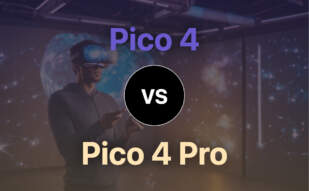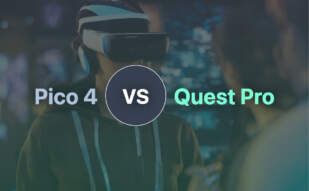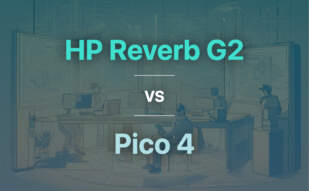Pico 4 Pro is a cutting-edge VR headset by Pico, designed to rival Meta’s Quest 2 with its advanced features and competitive pricing. Boasting a high-resolution display and innovative design, it caters to both consumers and enterprise users with its diverse offerings.
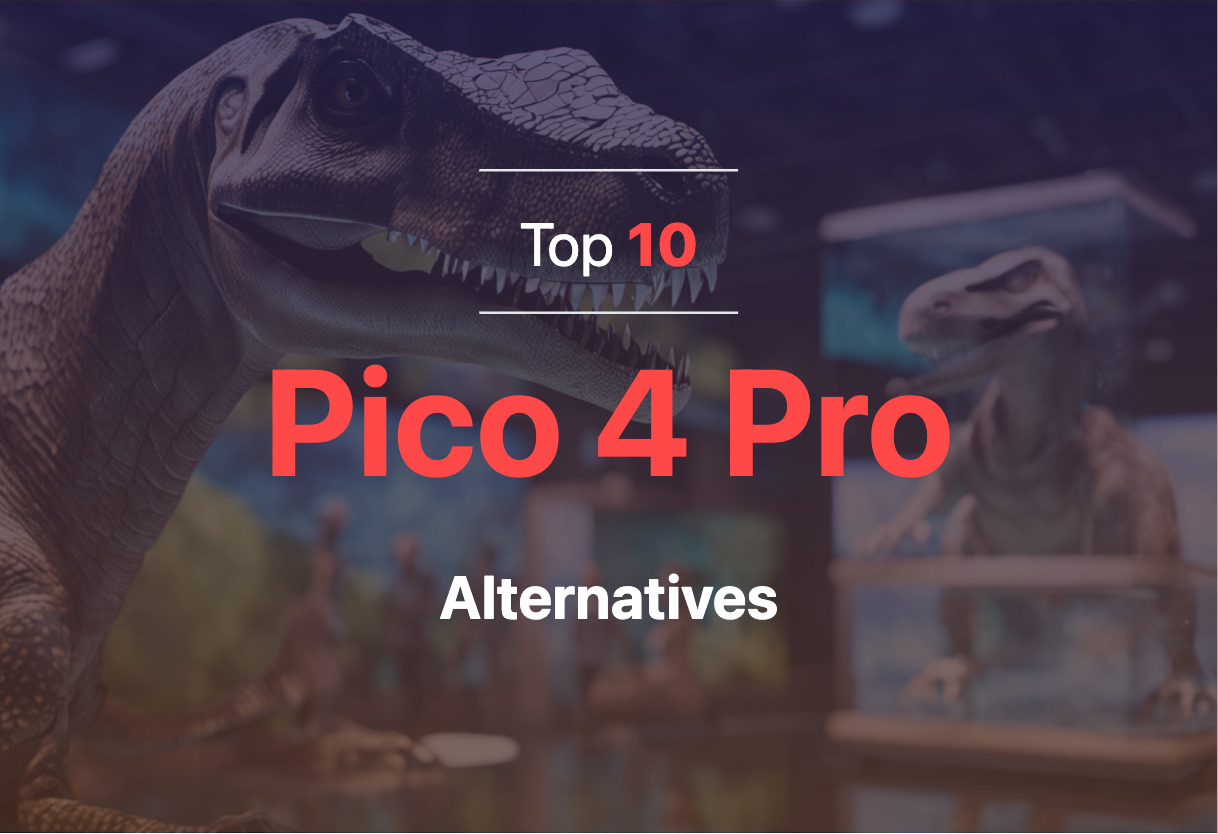
For those exploring options beyond Pico 4 Pro, alternatives include Quest Pro, Quest 3, Rift S, Index, Valve Index, Reverb G2, PSVR 2, and more, each offering unique experiences in the realm of virtual reality.
Pico 4
Enter the realm of immersive experience with Pico 4, a VR headset innovatively designed by ByteDance. Captivating visuals, exceptional comfort, and striking performance define this technology.
Top Pico 4 Features
- Handsome balance between design and comfort with equal weight distribution.
- Mighty Qualcomm Snapdragon XR2 with 8GB LPDDR4 RAM, delivering swift operations.
- Pico 4 Enterprise variant, sporting LPDDR5 RAM, specially designed for businesses.
- Mesmerizing over 2K resolution per eye via Fast-LCD displays, dishing out vivid visuals.
| Dimensions of Visor | 163mm x 80mm (adjustable length 255-310mm) |
| Weight (without strap and with accessories) | 295g and 586g respectively |
| Field of View | 105° |
Pico 4 Limitations
- Limited game library, as pointed out by NookGaming.
- Smaller field of view due to Pancake lenses, as recorded by Wikipedia.
Pico 4 Pricing
The Pico 4 is available for purchase starting at €429 on Amazon and XRshop.
Pico 4 Use Cases
Use case 1
Pico 4 can be a significant addition for businesses, with its Enterprise variant offering a more powerful RAM.
Use case 2
Photographers can greatly benefit from the Pancake lenses used in Pico 4, which are deemed to enhance image quality and reduce glare effects.
Use case 3
For VR enthusiasts, the Pico 4 offers an unparalleled fast-LCD display with over 2K resolution per eye, producing exceptional visual quality.
Pico 4 Enterprise
The Pico 4 Enterprise is a robust VR headset for business and enterprise use introduced by Pico, a company that has been monetizing VR hardware since 2016.
Featuring a 4K display and running on Qualcomm’s powerful Snapdragon XR2, this model has been built for smooth VR experiences with minimal lag and wide compatibility with a range of VR software.
Pico 4 Enterprise Top Features
- Built for extended use, featuring a lightweight and comfortable design.
- Equipped with a 4K display and powered by Qualcomm Snapdragon XR2 for powerful processing.
- Integrated with five external and three internal cameras, eliminating need for additional sensors.
- Offers high-definition visuals with a resolution of 2160 x 2160 per eye and a refresh rate of 90Hz.
- Uses eye and facial tracking, bolstering the interactivity of VR experiences.
- Facilitates real-world interaction through a colour passthrough display.
| Feature | Description |
|---|---|
| Memory | Contains 8GB of LPDDR5 memory, enabling faster processing of data. |
| Weight | Lightweight design weighing only 295g without the headband, the total weight comes to 586g. |
| Software | Runs on an open Android operating system, offering broad compatibility with a range of software. |
Pico 4 Enterprise Limitations
- Not designed for mixed or augmented reality use.
- Approximate battery life of two hours may limit extended usage.
- While it offers device management software, it is primarily tailored for larger organizations, which may limit its potential for smaller businesses.
Pico 4 Enterprise Pricing
As of now, no specific pricing information was provided in the company summary. More pricing details will need to be sought directly from the company itself.
Pico 4 Enterprise Use Cases
Use case 1: Interactive Training
In terms of functionality, the Pico 4 Enterprise enables interactive training through powerful processing and immersive visuals. Its eye and facial tracking features increase the realism and engagement of training simulations.
Use case 2: Museography
The high definition visuals and fluid interactive capabilities of the Pico 4 Enterprise make it suitable for elaborate usage in museography, creating virtual tours that enhance a visitor’s experience.
Use case 3: Simulations
Thanks to its vast memory and powerful Snapdragon XR2 processor, the Pico 4 Enterprise can support complex simulations with high visual fidelity and smooth performance.
Quest Pro
The Meta Quest Pro, a mixed-reality headset, integrates both VR and AR for a remarkable enterprise user experience.
Quest Pro Top Features
- Sleek, professional design with glossy black front panel
- Comfortable wraparound head strap with padding.
- 5 cameras (3 frontal, 2 side-facing) for an extensive field of view.
- Option for a full light blocker accessory for immersive comfort.
- Rechargeable less-cumbersome controllers with a dedicated charging cradle.
- Power-packed specifications: Snapdragon XR2+ processor (50% stronger than Quest 2); 12GB RAM; 256GB storage.
- Refined resolution: 1,920 x 1,800 pixels per eye;
- Enriched software: Meta Horizon Worlds that customize interfaces for collaborative work.
| Snapdragon XR2+ Processor | 50% stronger than Quest 2 |
| 12GB RAM | Supports high-performance graphics |
| 256GB Storage | For storing a multitude of AR/VR applications |
Quest Pro Disadvantages
- Higher cost compared to alternative VR/AR Headsets.
- Limited consumer software leveraging Quest Pro upgrades.
- The unpadded headset can cause discomfort.
Quest Pro Pricing
The Quest Pro comes in at a cost of $1499.99, positioning it as a more premium VR headset for professionals.
Quest Pro Use Cases
Use case 1: Professional Workflows
With features like the ‘standby mode’, ‘Contact Posters’ and enrichment of browser profiles, Quest Pro perfectly fits into the working environment of professionals requiring constant interaction and multitasking.
Use case 2: Gaming
The Quest Pro, powered by Snapdragon XR2+ chipset with a resolution equal to Quest 2, offers an immersive gaming experience for serious gamers.
Use case 3: Training and Education
Given its ability to blend virtual and the real world, the Quest Pro can be a powerful tool for education and training, making learning more interactive and efficient.
Quest 3
Meta Quest 3 takes the stage as the world’s first mass-market mixed reality headset. Hitting the shelves on October 10, 2023, Meta’s innovative creation vows to revolutionize the range of VR experiences with a noticeable leap in visual resolution and audio range compared to its predecessor.
Quest 3 Top Features
- Immersive Mixed Reality Experience: Enabled by the Snapdragon XR2 Gen 2 chipset.
- Improved Visual Display: Features a 4K+ Infinite Display & a 30% resolution hike.
- Enhanced Audio Experience: Upgraded sound clarity & a 40% louder audio range.
- Improved Hardware: Offers a more slim profile with balanced weight distribution.
| Feature | Effect |
|---|---|
| Mixed Reality Extension | It allows for interactive experiences with AR board games like Demeo, fitness training with Xponential+ or local multiplayer with shared spatial anchors. |
| Design overhaul | Increased comfort, a thinner profile and redesigned soft adjustable strap design. |
| Updated controllers | Improved gaming experience with new cutting edge control design. |
Quest 3 Disadvantages
- Price: Could be considered steep for some, especially the 512GB model.
- Compatibility: Only backwards compatible with Quest 2 titles. More availability required for wider applications.
Quest 3 Pricing
Meta Quest 3 is offered in two models, the 128GB model priced at $499.99 and the larger capacity 512GB model retailing for a higher $649.99.
Quest 3 Use Cases
Use case 1: Gaming
With the ability to power AR board games Demeo and a stunning visual experience on all games, the Quest 3 makes for a compelling purchase for gamers everywhere.
Use case 2: Fitness
The mixed reality experience and spatial awareness features of Quest 3 enables immersive fitness training experiences with platforms like Xponential+.
Use case 3: Sports Viewing
The streamlined design coupled with the enhanced visual experience makes the Quest 3 a great VR device for sports-viewing, especially with platforms like Xtadium.
Quest 2
Developed by Reality Labs, a division of Meta Platforms, Quest 2 is a VR headset delivering an immersive gaming experience with high-quality display and standalone operation. Released on October 13, 2020, it was initially known as Oculus Quest 2 and rebranded to Meta Quest 2 in 2022.
Quest 2 Top Features
- Processor: Qualcomm Snapdragon XR2
- Memory: 6 GB LPDDR4X
- Display: RGB LCD; 1832 x 1920 per eye, refresh rates 72-120 Hz
- Input: 6DOF inside-out tracking via four in-built cameras and two controllers
- Connectivity: USB-C, Bluetooth 5, Wi-Fi 6
| Key Specifications | Description |
|---|---|
| Internal Storage | 64 GB (discontinued), 128 GB, 256 GB |
| Sound | 2 built-in speakers, 3.5mm headphone jack |
| Online Services | Quest Store |
Quest 2 Limitations
- Battery life: Between 2-3 hours between charges
- Storage: Limited to internal storage with no room for expansion
Quest 2 Pricing
Quest 2’s pricing ranges from $299 for the 64GB variant to $399 for the 256GB model.
Quest 2 Use Cases
Use Case 1
With its high-quality display and competitive pricing, Quest 2 serves as an excellent entry-level VR headset for beginners.
Use Case 2
Quest 2’s immersive gaming functionality coupled with its standalone operation makes it a preferred choice for dedicated gamers.
Use Case 3
Thanks to its hand tracking feature, Quest 2 is useful for professionals in architecture and design looking to explore 3D modeling in VR.
Rift S
Developed by Facebook Technologies and Lenovo, Rift S is a significant successor the original Oculus Rift, launched in March 2019. Deriving mixed reviews, it improved upon its predecessor with higher resolution display and the “inside-out” positional tracking system.
Rift S Top Features
- Equipped with Oculus Insight tracking tech to provide an immersive gaming experience.
- Flaunts five built-in cameras (2 front, 1 top, 2 sides) for precise room-scale tracking.
- Boasts a comfortable Lenovo-designed halo headband optimized for weight distribution and comfort.
- Includes redesigned Oculus Touch controllers, fine-tuned for inside-out tracking.
- Makes use of a fast-switch LCD panel technology to offer sharp visuals and smooth interactions
| Display Quality | Offers 2560×1440 (1280×1440 per eye) resolution at 80Hz refresh rate. |
|---|---|
| Field of View | An impressive field of view of 115°. |
| IPD Adjustment | The headset uses software to adjust Interpupillary Distance, ranging from 61.5mm to 65.5mm. |
Rift S Limitations
- Critiqued for being just an incremental upgrade over the original Oculus Rift.
- Lacked significant changes or innovation, unlike its contemporary, the Oculus Quest.
- Rift S production ceased in June 2021.
Rift S Pricing
Originally priced at $399 at launch.
Rift S Use Cases
Use case 1: Gaming
The Rift S, with its immersive inside-out tracking system and Oculus Insight tech, transforms the gaming experience with heightened realism.
Use case 2: Virtual Meetings
The high-resolution display and comfortable halo headband design offer seamless virtual interaction experiences, suitable for business meetings and collaborative work.
Use case 3: Virtual Experiences
From virtual tours to education to museum visits, the level of detail that Rift S offers paves the way for a variety of real-world virtual experience simulations.
Index
Enter the realm of Index, a prominent tool indicating the popularity of programming languages. It’s a world where daily fluctuations of language usage trends are closely monitored, and analytical minds predict future shifts in digital linguistic favourability.
Index Top Features
- TIOBE Index: A dynamic tool detecting the popularity of programming languages in real-time.
- Insightful headlines: Rich, data-fueled headlines such as “C# closing gap with Java, 1.2% difference, C# likely to surpass in about 2 months” to keep you up-to-date.
- Finger on the pulse of trends: Spot annual gains and declines like Java’s -3.92% and C#’s +3.29%; stay ahead with Index’s sharp data analysis.
| Feature | Advantage |
|---|---|
| Open source C# | Freely available, embraced by developers. |
| Web Dev course | Comprehensive, from fundamentlas to advanced programming concepts. |
| Google Search’s three-stage operation | Get insights into how Crawling, Indexing, and Serving search results function. |
Index Limitations
- Index focuses on programming language usage, limiting its breadth of analysis for other tech areas.
- Intrinsic to its mode of operation, Indexing may encounter issues with low-quality content or website design that complicates the indexing process.
Index Pricing
As a wealth of knowledge, Index is priceless – quite literally. Given its open-source nature, it’s free to be used, analyzed, and even altered by its user community.
Index Use Cases
Use case 1: Data analytics
For data analysts, Index provides invaluable, realtime insights into programming language trends, aiding decisions like adopting new languages or abandoning declining ones.
Use case 2: Developers and programmers
Developers can use Index to stay in tune with industry trends, and adapt their skill sets to remain competitive in a swiftly evolving digital world.
Use case 3: Educators and students
Educators can use Index to gear their curriculum towards trending programming languages; students can pick and master languages that are currently in demand in the job market.
Valve Index

Unveiled to the world on June 28, 2019, Valve Index, manufactured by Valve, is a second-generation, consumer virtual reality headset. This extensive VR device, despite being impacted by production challenges due to COVID-19, managed to sell 149,000 sets, in part thanks to the announcement of Half-Life: Alyx.
Valve Index Top Features
- Dual 1440 x 1600 RGB LCDs that offer 50% more subpixels than OLED, intensifying visual sharpness.
- Flexible frame rates – 80/90/120/144Hz, designed for heightened optical comfort during extended play sessions.
- Enhanced Field of View (FOV) that outperforms HTC Vive by 20 degrees. Optics can be adjusted for user customization.
- Provisions for personalizing ergonomic settings like head size, face angle, and eye relief.
- An innovative off-ear audio solution that caters to varying head/ear shapes without sacrificing comfort.
- SteamVR 2.0 sensors for precise tracking, compatible with both SteamVR 1.0 and 2.0 base stations.
| Other features | Description |
| Controllers | Equipped with 87 sensors for tracking hand and finger positions. |
| Front Expansion Slot | Has a USB 3 Type-A port for custom additions. |
| Antimicrobial Fabric | Used in all contact surfaces for optimum hygiene. |
Valve Index Disadvantages
- Notably pricey.
- No eye tracking.
- Limited supply on release date.
- Initial setup can be complicated, particularly for room-scale sensor setup.
- Controllers might be unnecessary for certain games.
Valve Index Pricing
Valve Index initially retailed for $999. The cost of the headset alone has since decreased to $799. However, acquiring the full kit will still set you back the initial amount of $999.
Valve Index Use Cases
Use case 1
With its superior clarity and resolution, Valve Index provides an immersive VR experience for gaming enthusiasts.
Use case 2
Thanks to its compatible hardware options and fine-tuned lenses, Valve Index serves as a remarkable tool for VR content developers.
Use case 3
With the benefit of customizable optics and ergonomics, Valve Index also proves useful for educational institutions venturing into VR-infused teaching methods.
Reverb G2
Delve into the Reverb G2, HP’s solitary consumer headset offering designed for Microsoft’s Windows Mixed Reality platform. It’s an upgrade from the original 2019 Reverb, ideal for those seeking an improvement in comfort and motion tracking.
Reverb G2 Top Features
- Comfort-focused design with a memory foam-lined facemask, adjustable visor slider for pupillary distance, and external cameras for easy motion tracking.
- High-resolution LCD displays rendering images at 2160 by 2160 pixels at 90Hz, making it capable of creating sharp, clear images.
- Standalone platform that requires a powerful PC for maximum functionality, accompanied by two improved motion controllers and compatible with SteamVR.
- Facilitated setup via the Windows Mixed Reality portal, which helps users navigate the system efficiently.
| Feature | Benefit |
|---|---|
| Memory Foam Facemask | Enhanced user comfort, easily washable for hygiene purposes |
| Standalone Platform | Flexible, mobile experience without requirements for additional sensors or beacons |
| Clear Images | Offers one of the sharpest images in its price range, despite its lower resolution compared to some competitors |
Reverb G2 Downsides
- Occasional hiccups with the camera-based motion tracking causing a loss in controller tracking.
- Minor interface problems witnessed with the Windows Mixed Reality platform.
- Notably pricier compared to Oculus Quest 2 which offers a similar experience and higher resolution.
Reverb G2 Pricing
Retailed at $599.99, the Reverb G2 situates itself between high-end and budget-friendly VR headsets, offering a balance of features and price.
Reverb G2 Use Cases
Use Case 1: Gaming
The Reverb G2 provides gaming enthusiasts with a superior perceive. It supports several games including Aim Lab VR, Nvidia VR Funhouse, Project CARS Pagani Edition, and VRChat. Its clear and sharp pictures enhance gaming immersion.
Use Case 2: Virtual Workspaces
With its high-resolution display, Reverb G2 augments virtual workspaces, assisting professionals in immersive simulations, 3D modeling, and Interactive trainings.
Use Case 3: Education/Learning
Reverb G2 facilitates an innovative learning experience in educational sectors, allowing users to visualize complex concepts and engage in adaptive learning.
PSVR 2
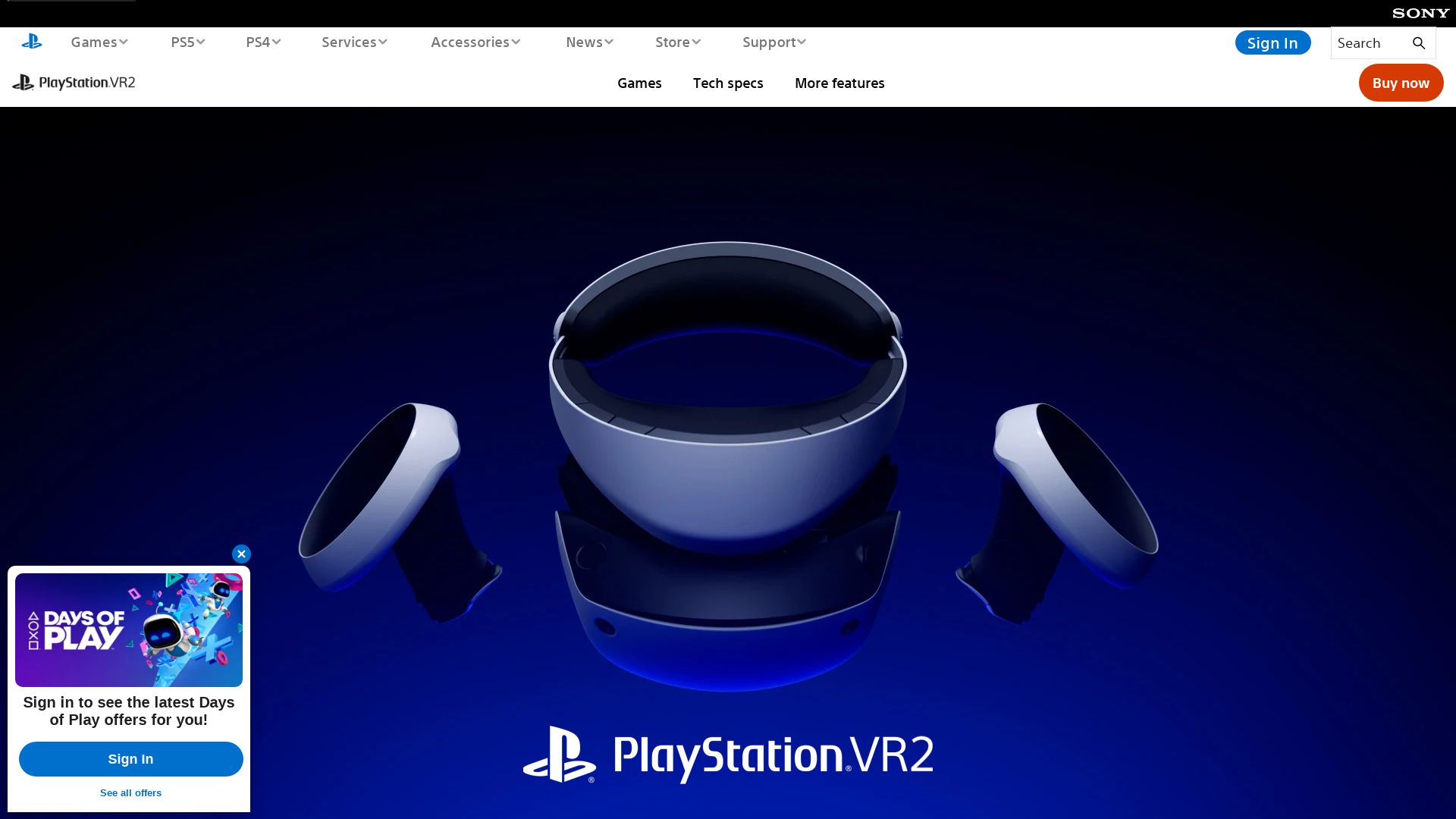
PSVR 2 is a powerful, PlayStation 5-exclusive VR headset that elevates the gaming experience despite its high cost.
PSVR 2 Top Features
- Improved design & performance: With a high-resolution of 2000 x 2040 per eye and a refresh rate of up to 120Hz, PSVR 2 outperforms its predecessor and Meta Quest 2.
- Sense controllers: Feature-filled, robust, with adaptive triggers and finger tracking.
- Innovative Tracking: Eye movement tracking inside the headset provides a more immersive experience.
| Feature | Detail |
|---|---|
| Comfort | Adjustable lenses, movable lens module, and sturdy headband ensure user comfort. |
| Connectivity | Direct connectivity to PlayStation 5 through a single USB-C input. |
| Audio | Included earbuds enhance the immersion in gameplay. |
PSVR 2 Limitations
- Exclusivity: Requires PlayStation 5 as prerequisite hardware, limiting its user base.
- Battery life: The controllers reportedly run out of power quickly.
- Non-backward compatibility: Limited games available; not compatible with non-upgraded PSVR1 games.
PSVR 2 Pricing
Attracting a high price tag of $549.99/£529.99, the PSVR 2’s cost often crosses the console’s price. Additional accessories like sense controller charging dock and pulse headset cost extra.
PSVR 2 Use Cases
Use case 1: Gaming
The PSVR 2 promises a superior VR gaming experience, thanks to its unique, immersive features like eye tracking and HDR support, although with a limited game pool.
Use case 2: VR Experiences
The headset offers a unique virtual reality experience, reducing the need for external cameras and processors. Its comfortable design ensures prolonged usage.
Use case 3: Media Consumption
For media enthusiasts, PSVR 2 delivers breathtaking visuals and a 110-degree field of view for consuming VR content.
Grant Sullivan
Content writer @ Aircada and self proclaimed board game strategist by day, AI developer by night.



